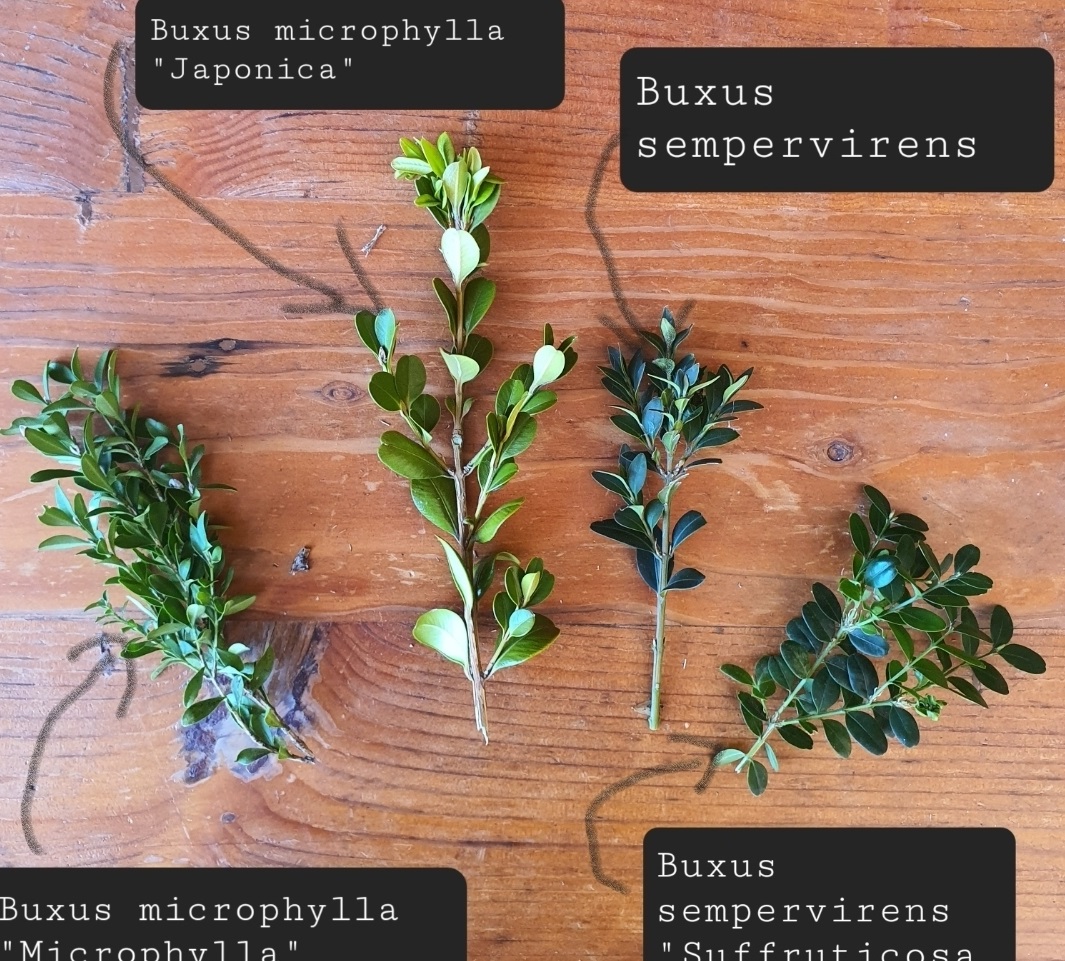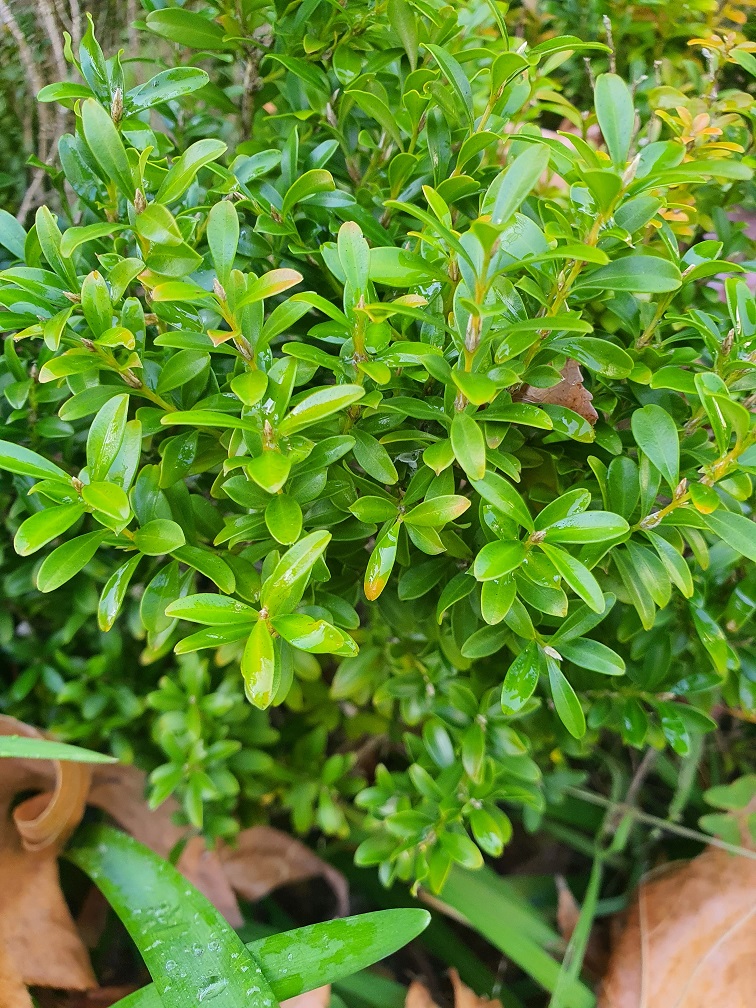
13 Jul The Ins and Outs of Buxus
After working in retail garden centres for over ten years I can not tell you how important it is to know which Buxus is which. Any new employees of the garden centre would be given a rundown of each species that we sold. We would clip off a few leaves of each species we had in stock and then stick the leaves on a sheet of paper with labels next them. We would then list out the main features of each species so the staff member could quickly learn a few key attributes of each species. Buxus was the plant genus that always caused lots of confusion.
I have found over the years that each species is suited to slightly different conditions and some are more susceptible to disease than others. Traditionally the English box (Buxus sempervirens) has been used in cooler climates whilst the Japanese Box (Buxus mixcrophylla “Japonica”) is more likely to be used in warmer climates. This is still true however I now tend to use Japanese Box for everything. Listed below I have tried to outline the key characteristics for the four main Buxus species, that you will find in garden centres. These species are mainly planted out as hedges or as pruned forms. When I mention their heights below I will be meaning what they can ideally reach with three – five years of growth and with regular tip pruning . It is not their fully mature heights as if you were to just leave them in the ground and let them grow over 20 years. The dimensions are just to give you an idea and they really can be manipulated to be smaller with pruning. I will from now on refer to them with their full botanical name – I think when sourcing any Buxus it is probably best if you do try to only use their botanical name, as even amongst growers there is confusion with the common names of this species. It can vary between states too.
All the Buxus can take frost.
See images of the leaf shape labelled below.


Buxus sempervirens – English Box
Height – 500mm – 750mm
Width – 300 – 400mm
Leaf shape – Pointy oval shaped
Leaf colour – Dark green glossy leaf
Spacing (for a hedge) – 3.5 plants per metre
Notes – This is the most traditionally used Box species. Slower growing than Buxus microphylla “Japonica”. Better grown in morning sun or part shade. More susceptible to scale especially if stressed in warmer weather. Beware this Buxus can also have a strong unpleasant odour that is more noticeable in warmer weather or when the sun is on the plants. I would avoid planting this species near a front door, near open windows or around entertaining areas.


Buxus sempervirens “Suffruticosa” – Dutch Box (Sometimes called Dwarf English Box)
Height – 400mm – 500mm
Width – 300mm
Leaf shape – oval shaped
Leaf colour – Dark green glossy leaf
Spacing (for a hedge) – 5 per metre
Notes – A dwarf species that naturally grows very dense. The foliage always looks like it is clumped in round form natural grows quite rounded. Will tolerate some shade.


Buxus microphylla “Japonica” – Japanese Box
Height – 600mm – 800mm. Can easily reach 1 metre.
Width – 400mm
Leaf shape – Rounded oval shape
Leaf colour –Bright mid green glossy leaf
Spacing (for a hedge) – 2.5 – 3 plants per metre
Notes – Generally it will take more heat and is more drought tolerant once established.
Overall fastest growing of all the Box species


Buxus microphylla “Microphylla” – Korean Box (somes times called Dwarf Japanese Box)
Height – 400mm
Width – 300mm
Leaf shape – long narrow oval shape – finer leaves compared to other Box
Leaf colour –lime green glossy leaf
Spacing (for a hedge) – 4 per metre
Notes – Naturally grows more compact, will respond to regular tip pruning, more drought tolerant than English and Dutch Box.

There are also many other species on the market such as Buxus Faulkiner, Buxus longifolia, Buxus “Golden Triumph”, Buxus variegata, Buxus elegans that are worth looking at but are not as commonly available.
Maintenance on Buxus Hedging
Soils/growing media
All Buxus species enjoy a well drained organic soil however they are very tough and can survive in a variety of soil as long as they have suitable nutrients.
All will survive well in pots with a Premium Potting Mix
Watering
All buxus species will need reliable moisture whilst they are becoming established. I have always found the Buxus microphylla “Japonica” to be the hardiest in all climates and can cope with slightly less water if needed.
Fertilising
They will all enjoy seasonal applications of a pelletised animal manure and a seaweed emulsion once a month whilst becoming established. I would normally use a six month slow release fertiliser on Buxus. Always make sure the plants are well watered before fertilizing. All pelletised and slow release fertiliser will need to be watered in well.
Pruning
The trick with growing a hedge is that you will need to complete regular tip pruning on any plant. Buxus will respond well to pruning. I would aim to do regular tip pruning to shape on plants rather than once a year hard cut back. Aim for end of late spring/early summer, early autumn and then after the first spring flush of growth. Ideally if you are in a frosty area and the Buxus are exposed to cold temperatures or snow you should avoid pruning back in the middle of winter. This is also true for the heat of summer. Try to avoid pruning in the heat of summer as you may open the inner foliage of the hedge up to sun burn.
Colour change in winter
In cooler weather all of the Box species mentioned above can take on a wintery colour if they are exposed to cold frosty weather especially cold winds and bright sunny days. The Buxus can take on a bronzed or orangey red colouring. To try and reduce the amount of bronzing to the Box foliage you can apply dolomite lime to the soil and an organic fertiliser to the soil in autumn. Never fear the plants will revert back to their normal colour when the weather warms up. Maintaining a fertiliser program throughout the year will ensure the new growth shoots through quickly in spring.



